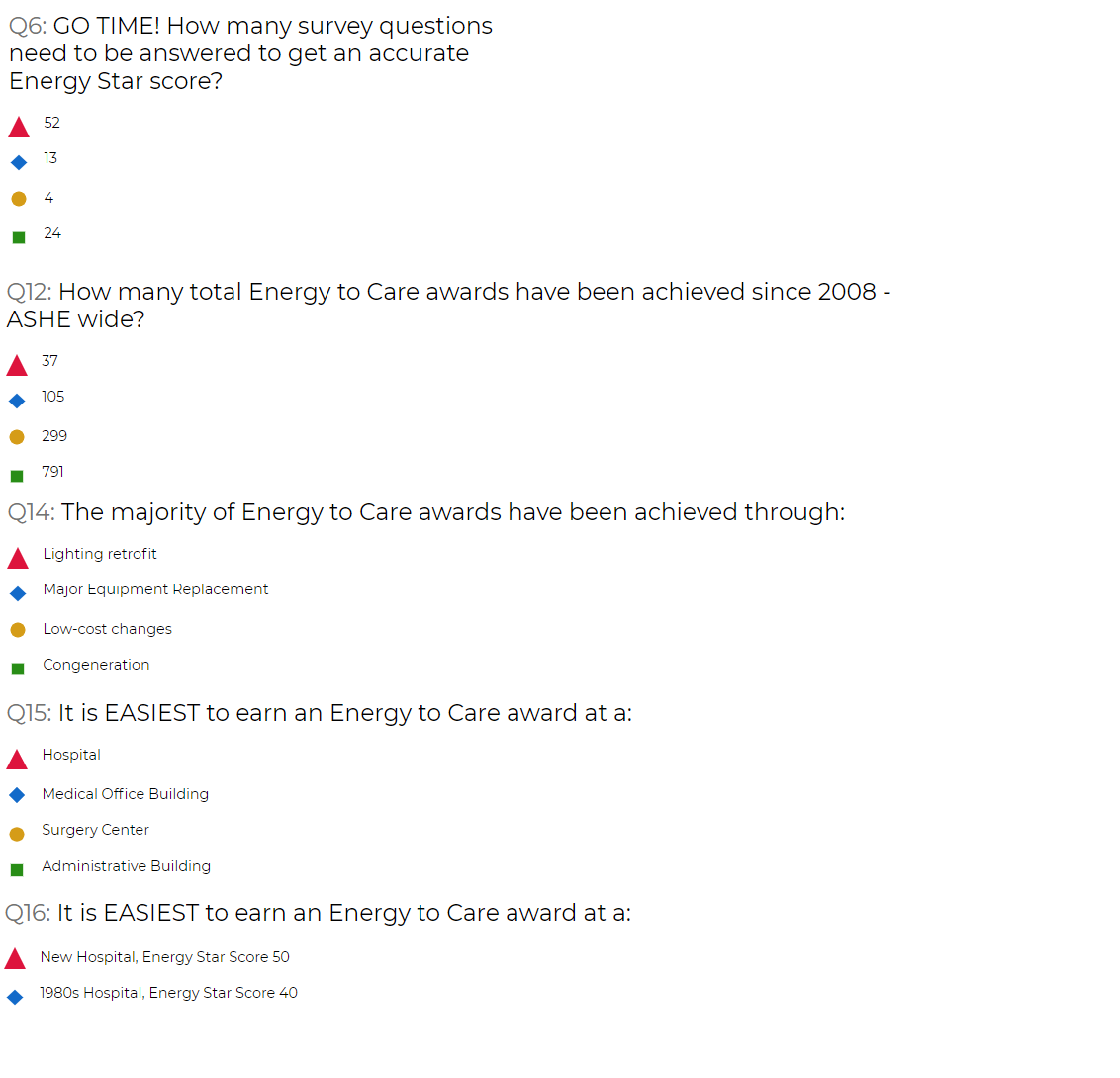Energy to Care Award Myths Busted
Savings are easier, cheaper, and not where you’re looking!
Tip #14
By Kevin Gombotz, PE, Vice President, Envinity, Inc.
Over the last few years we’ve helped more than a dozen hospital engineers receive Energy to Care awards for achieving a 10 percent reduction in energy consumption. It is fun work, challenging at times, and much easier than most realize. What’s the secret?
This year I’ve been busting the Energy to Care myths at state and district ASHE chapter meetings and greasing the skids for those who haven’t yet trimmed the award-winning 10 percent. Let’s look at some highlights from one of our recent quizzes; I encourage you to write down your answers before you proceed to the myth-busting answers.
Spoiler alert… don’t scroll down until you are ready for the answers…

How many survey questions need to be answered to get an accurate Energy Star score?
(A) 52 (B) 13 (C) 4 (D) 24
A shocking 97 percent of the audience members got this wrong, believing that signing up for Energy Star and Energy to Care is more complicated than in reality. Signing up really is that easy--only four survey questions plus your utility bills are required to receive an Energy Star score and enroll in Energy to Care. What are you waiting for?
How many total Energy to Care awards have been achieved since 2008, ASHE wide?
(A) 37 (B) 105 (C) 299 (D) 791
This question was answered incorrectly by 69 percent of respondents, who thought fewer peers had received Energy to Care awards. Every health facility should receive recognition for their efforts. In addition to bragging rights, award winners are finding that recognition gets noticed by leadership, resulting in further financial support for their energy efforts and capital infrastructure needs.
The majority of Energy to Care awards have been achieved through:
(A) Lighting retrofits (B) Major equipment replacement (C) Low-cost changes (D) Cogeneration
On this question, 69 percent of respondents were wrong, assuming serious capital projects are required to achieve the Energy to Care 10 percent reduction award. The common starting point in the Energy to Care case studies band the ASHE Energy Efficiency Monograph has been with low-cost, high-return fixes such as retrocommissioning and deploying unoccupied HVAC setbacks. Heavier lift projects with deeper savings typically get support after receiving recognition for achieving what is possible with little investment.
It is EASIEST to earn an Energy to Care award at this type of facility:
(A) Hospital (B) Medical office building (C) Surgery center (D) Administrative building
This question was answered incorrectly by 83 percent of respondents; most thought the in-patient facility would be the best starting point. In-patient buildings are the biggest piece of the overall utility budget and might be the biggest dollar savings; however, to achieve a 10 percent line-item reduction that the CFO will notice (and that will earn an Energy to Care award), a medical office building (MOB) may be your best bet. Why? Since MOBs have fewer compliance requirements, barriers to change are generally lower. Also, HVAC and lighting (over which facility managers have the most influence) are a larger percentage of the energy pie in a MOB. Last and most importantly, most medical office buildings are only occupied 60 hours a week, but have no unoccupied setbacks in place until an Energy to Care team gets involved.
It is EASIEST to earn an Energy to Care award at this age of hospital:
(A) New hospital, Energy Star score of 50 (B) 1980s hospital, Energy Star score 40
This one is counter-intuitive, but has a good explanation. While a higher Energy Star score does mean the newer hospital has less overall reduction opportunity, success lies in the effort required. New hospitals have the advantage of up-to-date drawings and full DDC controls. In addition, because newer facilities have a common design standard, energy opportunities are generally “rinse and repeat” endeavors to scale up facility wide.
About the Author
 Kevin Gombotz, PE, leads an interdisciplinary team of engineers and consultants to help health care buildings work better. By applying retrocommissioning, fault detection analytics, and commissioning-informed design, he works to sustain energy performance without compromising clinical operating requirements. Gombotz’s team has provided coaching and advisory services for energy efficiency work in more than 40 hospitals. He is passionate about the business case for sustainability, noting that his work has had the impact of taking 3,000 homes off the grid and has achieved 12 ASHE Energy to Care awards to date.
Kevin Gombotz, PE, leads an interdisciplinary team of engineers and consultants to help health care buildings work better. By applying retrocommissioning, fault detection analytics, and commissioning-informed design, he works to sustain energy performance without compromising clinical operating requirements. Gombotz’s team has provided coaching and advisory services for energy efficiency work in more than 40 hospitals. He is passionate about the business case for sustainability, noting that his work has had the impact of taking 3,000 homes off the grid and has achieved 12 ASHE Energy to Care awards to date.

